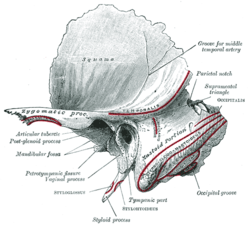Petrotympanic fissure
| Petrotympanic fissure | |
|---|---|
 Left temporal bone. Outer surface. (Petrotympanic fissure is labeled at left, fourth from top.) | |
 The right membrana tympani with the hammer and the chorda tympani, viewed from within, from behind, and from above. (Glaserian fissure labeled at center left.) | |
| Details | |
| Identifiers | |
| Latin | Fissura petrotympanica |
| TA | A02.1.06.074 |
| FMA | 55463 |
The petrotympanic fissure (also known as the squamotympanic fissure or the glaserian fissure) is a fissure in the temporal bone[1] that runs from the temporomandibular joint to the tympanic cavity.[2]
The mandibular fossa is bounded, in front, by the articular tubercle; behind, by the tympanic part of the bone, which separates it from the external acoustic meatus; it is divided into two parts by a narrow slit, the petrotympanic fissure.
It opens just above and in front of the ring of bone into which the tympanic membrane is inserted; in this situation it is a mere slit about 2 mm. in length. It lodges the anterior process and anterior ligament of the malleus, and gives passage to the anterior tympanic branch of the internal maxillary artery.
Eponym
It is also known as the "Glaserian fissure", after Johann Glaser.[3]
Contents
The contents of the fissure include communications of cranial nerve VII to the infratemporal fossa. A branch of cranial nerve VII, the chorda tympani, runs through the fissure to join with the lingual nerve providing special sensory (taste) innervation to the tongue.
Additional Images
 Base of the skull. Arrows indicate petrotympanic fissure.
Base of the skull. Arrows indicate petrotympanic fissure.
See also
References
This article incorporates text in the public domain from the 20th edition of Gray's Anatomy (1918)
- ↑ Petrotympanic+fissure at eMedicine Dictionary
- ↑ Eckerdal O (1991). "The petrotympanic fissure: a link connecting the tympanic cavity and the temporomandibular joint". Cranio. 9 (1): 15–22. PMID 1843474.
- ↑ "Glaserian fissure". Medcyclopaedia. Retrieved 2008-03-07.
External links
- Anatomy figure: 30:06-09 at Human Anatomy Online, SUNY Downstate Medical Center
- Anatomy photo:30:os-0108 at the SUNY Downstate Medical Center